





PRODUCTS
MESSAGES
LBO - Lithium Triborate
Introduction:
Lithium Triborate (LiB3O5 or LBO) is an excellent nonlinear optical crystal discovered and developed by FJIRSM, CAS (Fujian Institute of Research on the Structure of Matter, Chinese Academy of Sciences). LBO crystal and its NLO devices now are produced, manufactured and marketed by CASTECH, Inc (CASTECH).
CASTECH's LBO is featured by:
- Wide range of transparency (160-2600 nm, see Figure 1)
- High optical homogeneity (δn ≈ 10-6 /cm), and being free of inclusion
- Relatively high SHG efficiency (about 3 times that of KDP)
- High damage threshold
- Wide acceptance angle and small walk-off
- Type I and type Ⅱ non-critical phase matching (NCPM) in a wide wavelength range
- Spectral NCPM near 1300 nm
CASTECH offers:
- Strict quality control
- Large crystal size, aperture up to 55 x 55 mm2 and length up to 60 mm
- AR-coating, mounts and re-working services
- A large quantity of crystals in stock
- Fast delivery (15 days for polished only, 20 days for AR-coated)
Basic Properties:
|
Table 1. Chemical and Structural Properties |
|
|
Crystal Structure |
Orthorhombic, Space group Pna21, Point group mm2 |
|
Lattice Parameter |
a = 8.4473 Å, b = 7.3788 Å, c = 5.1395 Å, Z = 2 |
|
Melting Point |
About 834 ℃ |
|
Mohs Hardness |
6 Mohs |
|
Density |
2.47 g/cm3 |
|
Thermal Conductivity |
3.5 W/m/K |
|
Thermal Expansion Coefficients |
αx = 10.8 × 10-5 /K, αy = - 8.8 × 10-5 /K, αz = 3.4 × 10-5 /K |
|
Table 2. Optical and Nonlinear Optical Properties |
|
|
Transparency Range |
160-2600 nm |
|
SHG Phase Matchable Range |
551-2600 nm (Type Ⅰ) 790-2150 nm (Type Ⅱ) |
|
Therm-optic Coefficient (/℃, λ in μm) |
dnx / dT = - 9.3 ×10-6 dny / dT = - 13.6 × 10-6 dnz / dT = (- 6.3 - 2.1 λ) × 10-6 |
|
Absorption Coefficients |
<0.1% /cm at 1064 nm, <0.3% /cm at 532 nm |
|
Angle Acceptance |
6.54 mrad·cm (Φ, Type Ⅰ, 1064 SHG) 15.27 mrad·cm (θ, Type Ⅱ, 1064 SHG) |
|
Temperature Acceptance |
4.7 ℃·cm (Type Ⅰ, 1064 SHG) 7.5 ℃·cm (Type Ⅱ, 1064 SHG) |
|
Spectral Acceptance |
1.0 nm·cm (Type Ⅰ, 1064 SHG) 1.3 nm·cm (Type Ⅱ, 1064 SHG) |
|
Walk-off Angle |
0.60 ° (Type Ⅰ, 1064 SHG) 0.12 ° (Type Ⅱ, 1064 SHG) |
|
NLO Coefficients |
deff (Ⅰ) = d32 cosΦ (Type Ⅰ in XY plane) deff (Ⅰ) = d31 cos2θ + d32 sin2θ (Type Ⅰ in XZ plane) deff (Ⅱ) = d31 cosθ (Type Ⅱ in YZ plane) deff (Ⅱ) = d31 cos2θ + d32 sin2θ (Type Ⅱ in XZ plane) |
|
Non-vanished NLO Susceptibilities |
d31= 1.05 ± 0.09 pm/V d32= -0.98 ± 0.09 pm/V d33= 0.05 ± 0.006 pm/V |
|
Sellmeier Equations (λ in μm) |
nx2 = 2.454140 + 0.011249 / (λ2 - 0.011350) - 0.014591 λ2 - 6.60 × 10-5 λ4 ny2 = 2.539070 + 0.012711 / (λ2 - 0.012523) - 0.018540 λ2 + 2.00 × 10-4 λ4 nz2 = 2.586179 + 0.013099 / (λ2 - 0.011893) - 0.017968 λ2 - 2.26 × 10-4 λ4 |
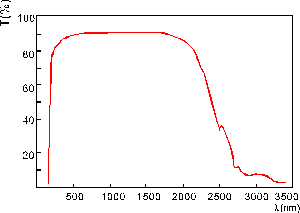
Figure 1. Transparency curve of LBO
SHG and THG at Room Temperature:
LBO is phase matchable for the SHG and THG of Nd:YAG and Nd:YLF lasers, using either type I or type II interaction. For the SHG at room temperature, type I phase matching can be reached and has the maximum effective SHG coefficient in the principal XY and XZ planes (see Fig. 2) in a wide wavelength range from 551nm to about 2600 nm (the effective SHG coefficient see Table 2).
The optimum type II phase matching falls in the principal YZ and XZ planes (see Fig.2), (the effective SHG coefficient see Table 2).
SHG conversion efficiencies of more than 70% for pulse and 30% for cw Nd:YAG lasers, and THG conversion efficiency over 60% for pulse Nd:YAG laser have been observed by using CASTECH's LBO crystals.
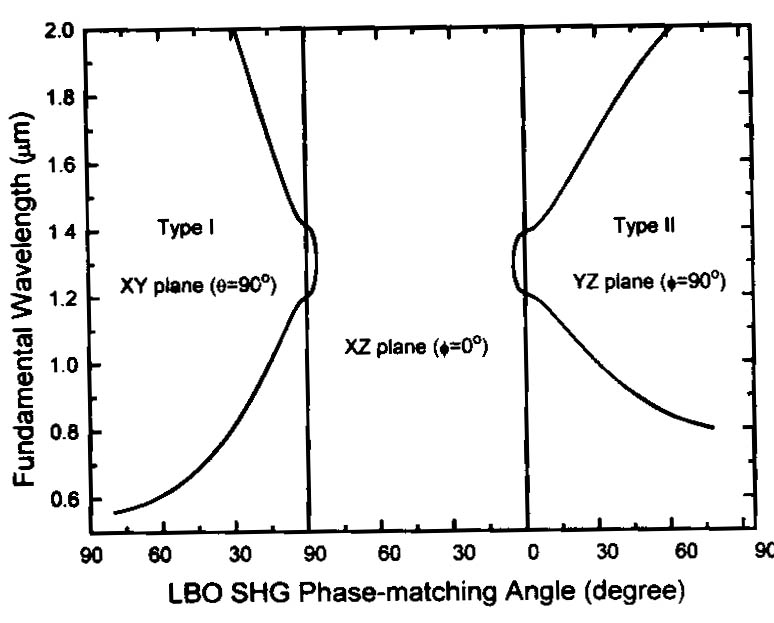
Figure 2. SHG tuning curves of LBO
Applications for SHG and THG at Room Temperature:
- More than 480 mW output at 395 nm is generated by frequency doubling a 2 W mode-locked Ti:Sapphire laser (<2 ps, 82 MHz).
- Over 80 W green output is obtained by SHG of a Q-switched Nd:YAG laser in a type Ⅱ 18 mm long LBO crystal.
- The frequency doubling of a diode pumped Nd:YLF laser (>500 μJ @1047 nm, <7 ns, 0-10 KHz) reaches over 40% conversion efficiency in a 9 mm long LBO crystal.
- The VUV output at 187.7 nm is obtained by sum-frequency generation.
- 2 mJ/pulse diffraction-limited beam at 355 nm is obtained by intracavity frequency tripling a Q-switched Nd:YAG laser.
Non-Critical Phase Matching of LBO:
As shown in Table 3, Non-Critical Phase Matching (NCPM) of LBO is featured by no walk-off, very wide acceptance angle and maximum effective coefficient. It promotes LBO to work in its optimal condition. SHG conversion efficiency of more than 70% for pulse and 30% for cw Nd:YAG lasers have been obtained, with good output stability and beam quality.
As shown in Fig.3, type I and type II non-critical phase matching can be reached along X-axis and Z-axis at room temperature, respectively.
CASTECH develops an assembly of oven and temperature controller for NCPM applications. Please refer to Page 72 for more technical data.

Figure 3. NCPM temperature tuning curves of LBO
|
Table 3. Properties of type Ⅰ NCPM SHG at 1064 nm |
|
|
NCPM Temperature |
148 ℃ |
|
Acceptance Angle |
52 mrad·cm |
|
Walk-off Angle |
0 |
|
Temperature Bandwidth |
4 ℃·cm |
|
Effective SHG Coefficient |
2.69 × d36 (KDP) =1.18 pm/V |
Applications for NCPM:
- Over 11 W of average power at 532 nm was obtained by extra-cavity SHG of a 25 W Antares mode-locked Nd:YAG laser (76 MHz, 80 ps).
- 20 W green output was generated by frequency doubling a medical multi-mode Q-switched Nd:YAG laser. Higher green output is expected with higher input power.
LBO's OPO and OPA:
LBO is an excellent NLO crystal for OPOs and OPAs with a widely tunable wavelength range and high powers. The OPO and OPA which are pumped by the SHG and THG of Nd:YAG laser and XeCl excimer laser at 308 nm have been reported. The unique properties of type Ⅰ and type Ⅱ phase matching as well as the NCPM leave a large room in the research and applications of LBO's OPO and OPA. Fig. 4 shows the calculated type Ⅰ OPO tuning curves of LBO pumped by the SHG, THG and FOHG of Nd:YAG laser in XY plane at the room temperature. And Fig. 5 illustrates type Ⅱ OPO tuning curves of LBO pumped by the SHG and THG of Nd:YAG laser in XZ plane.

Figure 4. Type I OPO tuning curves of LBO

Figure 5. Type II OPO tuning curves of LBO
Applications for OPO and OPA:
- 540-1030 nm tunable wavelength range with a quite high overall conversion efficiency has obtained with OPO pumped at 355 nm.
- Type Ⅰ OPA pumped at 355 nm with the pump-to-signal energy conversion efficiency of 30% has been reported.
- Type Ⅱ NCPM OPO pumped by a XeCl excimer laser at 308 nm has achieved 16.5% conversion efficiency, and moderate tunable wavelength ranges can be obtained with different pumping sources and temperature tuning.
- By using the NCPM technique, type Ⅰ OPA pumped by the SHG of a Nd:YAG laser at 532 nm was also observed to cover a wide tunable range from 750 nm to 1800 nm by temperature tuning from 106.5 ℃ to 148.5 ℃.
- By using type Ⅱ NCPM LBO as an optical parametric generator (OPG) and type Ⅰ critical phase-mateched BBO as an OPA, a narrow linewidth (0.15 nm) and high pump-to-signal energy conversion efficiency (32.7%) was obtained when it is pumped by a 4.8 mJ, 30 ps laser at 354.7 nm. Wavelength tuning range from 482.6 nm to 415.9 nm was covered either by increasing the temperature of LBO or by rotating BBO.
LBO's Spectral NCPM:
Not only the ordinary non-critical phase match (NCPM) for angular variation but also the non-critical phase matching for spectral variation (SNCPM) can be achieved in the LBO crystal. As shown in Fig. 2, the phase matching retracing positions are λ1 = 1.31 μm with θ = 86.4 °, Φ = 0 °, for Type Ⅰ and λ2 = 1.30 μm with θ = 4.8 °, Φ = 0 °, for Type Ⅱ. The phase matching at these position possess very large spectral acceptances Δλ at λ1 and λ2, which are 57 nm·cm and 74 nm·cm respectively, much larger than that of other NLO crystals. These spectral characteristics are very suitable for doubling broadband coherent radiations near 1.3 μm, such as those from some diode lasers, and some OPA/OPO output without linewidth-narrowing components.
AR-coating:
CATECH provides the following AR-coatings:
- Dual Band AR-coating (DBAR) of LBO for SHG of 1064 nm; Frequency-tripled antireflection coating of LBO for THG of 1064 nm
- Low reflectance (R<0.2% @1064 nm, R<0.5% @532 nm, R<0.5% @355 nm) ;super low reflectivity of R<0.05% @1064 nm and R<0.1% @532 nm is available upon request
- Broad Band AR-coating (BBAR) of LBO for SHG of tunable lasers
- IBS, IAD coating methods are available upon request
- High damage threshold
- Long durability
- Other coating are available upon request
LBO's Parameters:
|
Table 4. Specifications |
|
|
Dimension Tolerance |
(W±0.1 mm) × (H±0.1 mm) × (L+0.5/-0.1 mm) × (L≧2.5 mm) (W±0.1 mm) × (H±0.1 mm) × (L+0.1/-0.1 mm) × (L<2.5 mm) |
|
Clear Aperture |
Central 90% of the diameter |
|
Surface Quality (Scratch/Dig) |
10/5 to MIL-PRF-13830B |
|
Flatness |
≦λ/8 @633 nm |
|
Transmitted Wave-front Distortion |
≦λ/8 @633 nm |
|
Parallelism |
20 arc sec |
|
Perpendicularity |
≦15 arc min |
|
Angle Tolerance |
Δθ≦0.25 °, ΔΦ≦0.25 ° |
|
Chamfer |
≦0.2 mm × 45 ° |
|
Chip |
≦0.1 mm |
|
Damage Threshold |
>10 GW/cm2 @1064 nm, 10 ns, 10 Hz (polished only) >1 GW/cm2 @1064 nm, 10 ns, 10 Hz (AR-coated) >0.5 GW/cm2 @532 nm, 10 ns, 10 Hz (AR-coated) |
|
Quality Warranty Period |
One year under proper use. |
Notes:
- LBO has a low susceptibility to moisture. Users are advised to provide dry conditions for both the use and preservation of LBO.
- Polished surfaces of LBO require precautions to prevent any damage.
- CASTECH engineers can select and design the best crystal for you, based on the main parameters of your laser, such as energy per pulse, pulse width and repetition rate for a pulsed laser, power for a cw laser, laser beam diameter, mode condition, divergence, wavelength tuning range, etc.
- For thin crystals, CASTECH can provide with free holders.
Products
-
LBO - Lithium Triborate
- LBO is an excellent nonlinear optical crystal discovered by FIRSM affiliated to Chinese Academy of Sciences. Its NLO devices now are produced, manufactured and marketed by CASTECH.
-
Introduction:
Lithium Triborate (LiB3O5 or LBO) is an excellent nonlinear optical crystal discovered and developed by FJIRSM, CAS (Fujian Institute of Research on the Structure of Matter, Chinese Academy of Sciences). LBO crystal and its NLO devices now are produced, manufactured and marketed by CASTECH, Inc (CASTECH).
CASTECH's LBO is featured by:
- Wide range of transparency (160-2600 nm, see Figure 1)
- High optical homogeneity (δn ≈ 10-6 /cm), and being free of inclusion
- Relatively high SHG efficiency (about 3 times that of KDP)
- High damage threshold
- Wide acceptance angle and small walk-off
- Type I and type Ⅱ non-critical phase matching (NCPM) in a wide wavelength range
- Spectral NCPM near 1300 nm
CASTECH offers:
- Strict quality control
- Large crystal size, aperture up to 55 x 55 mm2 and length up to 60 mm
- AR-coating, mounts and re-working services
- A large quantity of crystals in stock
- Fast delivery (15 days for polished only, 20 days for AR-coated)
Basic Properties:
|
Table 1. Chemical and Structural Properties |
|
|
Crystal Structure |
Orthorhombic, Space group Pna21, Point group mm2 |
|
Lattice Parameter |
a = 8.4473 Å, b = 7.3788 Å, c = 5.1395 Å, Z = 2 |
|
Melting Point |
About 834 ℃ |
|
Mohs Hardness |
6 Mohs |
|
Density |
2.47 g/cm3 |
|
Thermal Conductivity |
3.5 W/m/K |
|
Thermal Expansion Coefficients |
αx = 10.8 × 10-5 /K, αy = - 8.8 × 10-5 /K, αz = 3.4 × 10-5 /K |
|
Table 2. Optical and Nonlinear Optical Properties |
|
|
Transparency Range |
160-2600 nm |
|
SHG Phase Matchable Range |
551-2600 nm (Type Ⅰ) 790-2150 nm (Type Ⅱ) |
|
Therm-optic Coefficient (/℃, λ in μm) |
dnx / dT = - 9.3 ×10-6 dny / dT = - 13.6 × 10-6 dnz / dT = (- 6.3 - 2.1 λ) × 10-6 |
|
Absorption Coefficients |
<0.1% /cm at 1064 nm, <0.3% /cm at 532 nm |
|
Angle Acceptance |
6.54 mrad·cm (Φ, Type Ⅰ, 1064 SHG) 15.27 mrad·cm (θ, Type Ⅱ, 1064 SHG) |
|
Temperature Acceptance |
4.7 ℃·cm (Type Ⅰ, 1064 SHG) 7.5 ℃·cm (Type Ⅱ, 1064 SHG) |
|
Spectral Acceptance |
1.0 nm·cm (Type Ⅰ, 1064 SHG) 1.3 nm·cm (Type Ⅱ, 1064 SHG) |
|
Walk-off Angle |
0.60 ° (Type Ⅰ, 1064 SHG) 0.12 ° (Type Ⅱ, 1064 SHG) |
|
NLO Coefficients |
deff (Ⅰ) = d32 cosΦ (Type Ⅰ in XY plane) deff (Ⅰ) = d31 cos2θ + d32 sin2θ (Type Ⅰ in XZ plane) deff (Ⅱ) = d31 cosθ (Type Ⅱ in YZ plane) deff (Ⅱ) = d31 cos2θ + d32 sin2θ (Type Ⅱ in XZ plane) |
|
Non-vanished NLO Susceptibilities |
d31= 1.05 ± 0.09 pm/V d32= -0.98 ± 0.09 pm/V d33= 0.05 ± 0.006 pm/V |
|
Sellmeier Equations (λ in μm) |
nx2 = 2.454140 + 0.011249 / (λ2 - 0.011350) - 0.014591 λ2 - 6.60 × 10-5 λ4 ny2 = 2.539070 + 0.012711 / (λ2 - 0.012523) - 0.018540 λ2 + 2.00 × 10-4 λ4 nz2 = 2.586179 + 0.013099 / (λ2 - 0.011893) - 0.017968 λ2 - 2.26 × 10-4 λ4 |

Figure 1. Transparency curve of LBO
SHG and THG at Room Temperature:
LBO is phase matchable for the SHG and THG of Nd:YAG and Nd:YLF lasers, using either type I or type II interaction. For the SHG at room temperature, type I phase matching can be reached and has the maximum effective SHG coefficient in the principal XY and XZ planes (see Fig. 2) in a wide wavelength range from 551nm to about 2600 nm (the effective SHG coefficient see Table 2).
The optimum type II phase matching falls in the principal YZ and XZ planes (see Fig.2), (the effective SHG coefficient see Table 2).
SHG conversion efficiencies of more than 70% for pulse and 30% for cw Nd:YAG lasers, and THG conversion efficiency over 60% for pulse Nd:YAG laser have been observed by using CASTECH's LBO crystals.

Figure 2. SHG tuning curves of LBO
Applications for SHG and THG at Room Temperature:
- More than 480 mW output at 395 nm is generated by frequency doubling a 2 W mode-locked Ti:Sapphire laser (<2 ps, 82 MHz).
- Over 80 W green output is obtained by SHG of a Q-switched Nd:YAG laser in a type Ⅱ 18 mm long LBO crystal.
- The frequency doubling of a diode pumped Nd:YLF laser (>500 μJ @1047 nm, <7 ns, 0-10 KHz) reaches over 40% conversion efficiency in a 9 mm long LBO crystal.
- The VUV output at 187.7 nm is obtained by sum-frequency generation.
- 2 mJ/pulse diffraction-limited beam at 355 nm is obtained by intracavity frequency tripling a Q-switched Nd:YAG laser.
Non-Critical Phase Matching of LBO:
As shown in Table 3, Non-Critical Phase Matching (NCPM) of LBO is featured by no walk-off, very wide acceptance angle and maximum effective coefficient. It promotes LBO to work in its optimal condition. SHG conversion efficiency of more than 70% for pulse and 30% for cw Nd:YAG lasers have been obtained, with good output stability and beam quality.
As shown in Fig.3, type I and type II non-critical phase matching can be reached along X-axis and Z-axis at room temperature, respectively.
CASTECH develops an assembly of oven and temperature controller for NCPM applications. Please refer to Page 72 for more technical data.

Figure 3. NCPM temperature tuning curves of LBO
|
Table 3. Properties of type Ⅰ NCPM SHG at 1064 nm |
|
|
NCPM Temperature |
148 ℃ |
|
Acceptance Angle |
52 mrad·cm |
|
Walk-off Angle |
0 |
|
Temperature Bandwidth |
4 ℃·cm |
|
Effective SHG Coefficient |
2.69 × d36 (KDP) =1.18 pm/V |
Applications for NCPM:
- Over 11 W of average power at 532 nm was obtained by extra-cavity SHG of a 25 W Antares mode-locked Nd:YAG laser (76 MHz, 80 ps).
- 20 W green output was generated by frequency doubling a medical multi-mode Q-switched Nd:YAG laser. Higher green output is expected with higher input power.
LBO's OPO and OPA:
LBO is an excellent NLO crystal for OPOs and OPAs with a widely tunable wavelength range and high powers. The OPO and OPA which are pumped by the SHG and THG of Nd:YAG laser and XeCl excimer laser at 308 nm have been reported. The unique properties of type Ⅰ and type Ⅱ phase matching as well as the NCPM leave a large room in the research and applications of LBO's OPO and OPA. Fig. 4 shows the calculated type Ⅰ OPO tuning curves of LBO pumped by the SHG, THG and FOHG of Nd:YAG laser in XY plane at the room temperature. And Fig. 5 illustrates type Ⅱ OPO tuning curves of LBO pumped by the SHG and THG of Nd:YAG laser in XZ plane.

Figure 4. Type I OPO tuning curves of LBO

Figure 5. Type II OPO tuning curves of LBO
Applications for OPO and OPA:
- 540-1030 nm tunable wavelength range with a quite high overall conversion efficiency has obtained with OPO pumped at 355 nm.
- Type Ⅰ OPA pumped at 355 nm with the pump-to-signal energy conversion efficiency of 30% has been reported.
- Type Ⅱ NCPM OPO pumped by a XeCl excimer laser at 308 nm has achieved 16.5% conversion efficiency, and moderate tunable wavelength ranges can be obtained with different pumping sources and temperature tuning.
- By using the NCPM technique, type Ⅰ OPA pumped by the SHG of a Nd:YAG laser at 532 nm was also observed to cover a wide tunable range from 750 nm to 1800 nm by temperature tuning from 106.5 ℃ to 148.5 ℃.
- By using type Ⅱ NCPM LBO as an optical parametric generator (OPG) and type Ⅰ critical phase-mateched BBO as an OPA, a narrow linewidth (0.15 nm) and high pump-to-signal energy conversion efficiency (32.7%) was obtained when it is pumped by a 4.8 mJ, 30 ps laser at 354.7 nm. Wavelength tuning range from 482.6 nm to 415.9 nm was covered either by increasing the temperature of LBO or by rotating BBO.
LBO's Spectral NCPM:
Not only the ordinary non-critical phase match (NCPM) for angular variation but also the non-critical phase matching for spectral variation (SNCPM) can be achieved in the LBO crystal. As shown in Fig. 2, the phase matching retracing positions are λ1 = 1.31 μm with θ = 86.4 °, Φ = 0 °, for Type Ⅰ and λ2 = 1.30 μm with θ = 4.8 °, Φ = 0 °, for Type Ⅱ. The phase matching at these position possess very large spectral acceptances Δλ at λ1 and λ2, which are 57 nm·cm and 74 nm·cm respectively, much larger than that of other NLO crystals. These spectral characteristics are very suitable for doubling broadband coherent radiations near 1.3 μm, such as those from some diode lasers, and some OPA/OPO output without linewidth-narrowing components.
AR-coating:
CATECH provides the following AR-coatings:
- Dual Band AR-coating (DBAR) of LBO for SHG of 1064 nm; Frequency-tripled antireflection coating of LBO for THG of 1064 nm
- Low reflectance (R<0.2% @1064 nm, R<0.5% @532 nm, R<0.5% @355 nm) ;super low reflectivity of R<0.05% @1064 nm and R<0.1% @532 nm is available upon request
- Broad Band AR-coating (BBAR) of LBO for SHG of tunable lasers
- IBS, IAD coating methods are available upon request
- High damage threshold
- Long durability
- Other coating are available upon request
LBO's Parameters:
|
Table 4. Specifications |
|
|
Dimension Tolerance |
(W±0.1 mm) × (H±0.1 mm) × (L+0.5/-0.1 mm) × (L≧2.5 mm) (W±0.1 mm) × (H±0.1 mm) × (L+0.1/-0.1 mm) × (L<2.5 mm) |
|
Clear Aperture |
Central 90% of the diameter |
|
Surface Quality (Scratch/Dig) |
10/5 to MIL-PRF-13830B |
|
Flatness |
≦λ/8 @633 nm |
|
Transmitted Wave-front Distortion |
≦λ/8 @633 nm |
|
Parallelism |
20 arc sec |
|
Perpendicularity |
≦15 arc min |
|
Angle Tolerance |
Δθ≦0.25 °, ΔΦ≦0.25 ° |
|
Chamfer |
≦0.2 mm × 45 ° |
|
Chip |
≦0.1 mm |
|
Damage Threshold |
>10 GW/cm2 @1064 nm, 10 ns, 10 Hz (polished only) >1 GW/cm2 @1064 nm, 10 ns, 10 Hz (AR-coated) >0.5 GW/cm2 @532 nm, 10 ns, 10 Hz (AR-coated) |
|
Quality Warranty Period |
One year under proper use. |
Notes:
- LBO has a low susceptibility to moisture. Users are advised to provide dry conditions for both the use and preservation of LBO.
- Polished surfaces of LBO require precautions to prevent any damage.
- CASTECH engineers can select and design the best crystal for you, based on the main parameters of your laser, such as energy per pulse, pulse width and repetition rate for a pulsed laser, power for a cw laser, laser beam diameter, mode condition, divergence, wavelength tuning range, etc.
- For thin crystals, CASTECH can provide with free holders.


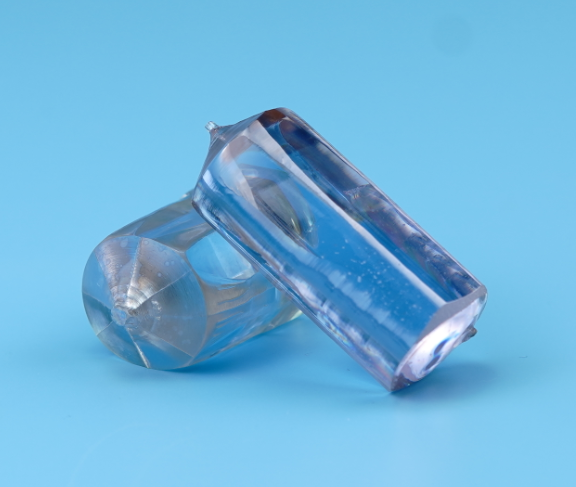
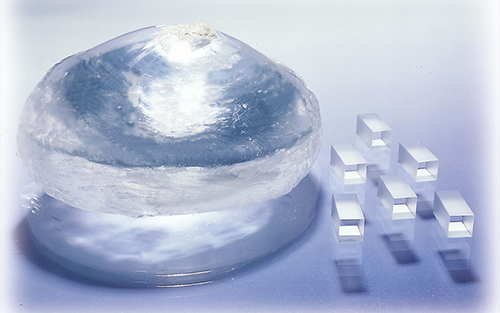
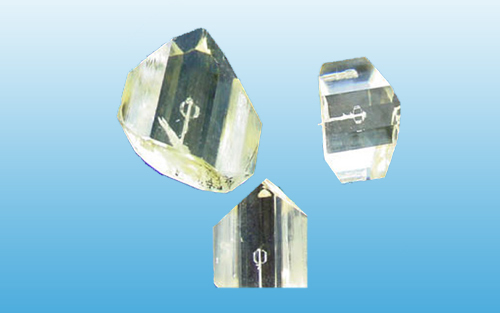
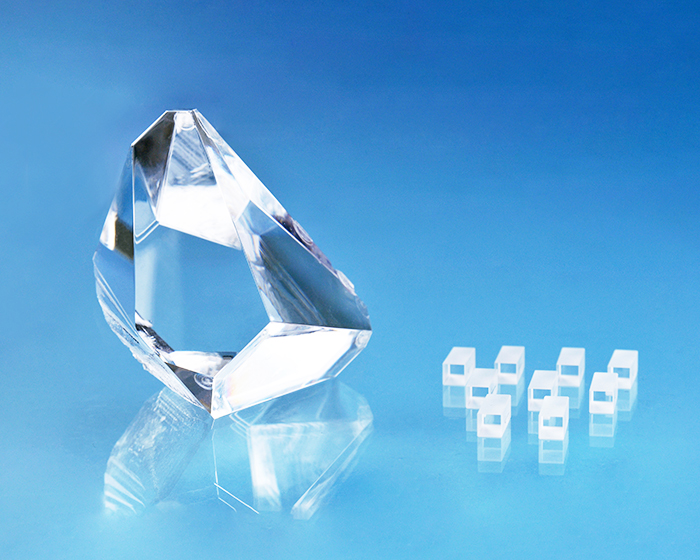
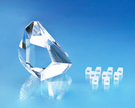
 Enquiry
Enquiry E-mail
E-mail





